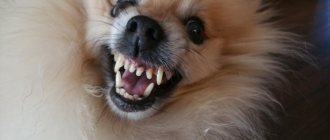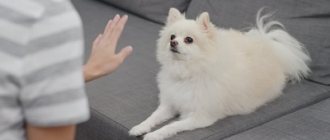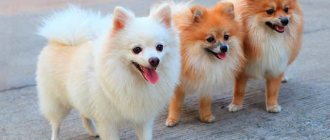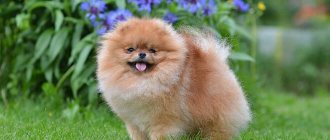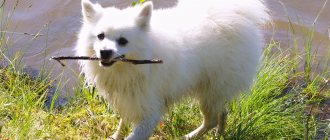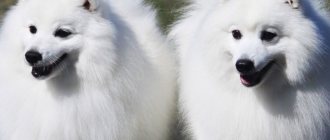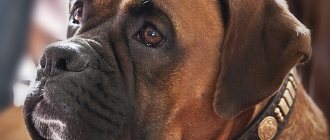Spitz is an ancient breed, whose ancestors were turf dogs living in the Stone Age. In the course of evolution, as well as as a result of breeders’ selection work, several varieties of Spitz appeared, differing in size.
The smallest representative of the breed was the Miniature Spitz. This is a decorative lap dog with a cool disposition. This is a fearless creature, ready to protect its owner at any moment. The Dwarf Spitz is suitable for active people and those who are willing to devote a lot of time to caring for and raising the dog.
Origin and history of the breed
The Spitz's ancestors were first domesticated more than 5,000 years ago. Archaeological excavations in peat deposits found the remains of similar dogs. Researchers believe that the ancestors of the breed were huskies, chow chows, and huskies. It was from them that Spitz dogs got their endurance, stubbornness, and temperament.
The dogs, similar to modern dwarf Spitz dogs, were called “Spitzhund” in the 15th century. According to one version, breeding of the breed began in the city of Württemberg, according to another, in the German region of Pomerania.
The Dwarf Spitz was first recognized in England in 1870. For selection, breeders used Spitz dogs brought from Germany. In 1900, the first club of breed lovers was created in America.
In Russia, after the coup of 1917, dwarf Spitz dogs were practically exterminated, as relics of the bourgeois past. After World War II, these dogs were again imported to the USSR as trophies, and since then a new round of their popularity has begun.
Origin story
German Spitz are one of the oldest European breeds. Their ancestor was a turf dog that lived in Germany back in the Stone Age. In the Middle Ages, Spitz dogs began to spread throughout Europe, where they were used for various purposes.
In Germany and the Netherlands, they were guard dogs for the poor, as they were valued for their sensitivity and loud voices and did not require much food due to their small size. In England, Spitz dogs were bred as decorative dogs, immediately determining that the smaller the representative of the breed, the better. Thanks to this, from dogs that reached 40 cm at the withers, Spitz turned into miniature pets, more like a toy.
Modern varieties of German Spitz differ from each other in appearance and size, however, all cynologists are unanimous in the opinion that they have the same ancestors. Therefore, Spitz are combined in the International Classification into 1 breed, which has different subspecies. At the same time, in a number of countries, some varieties of German Spitz are classified as independent breeds.
The first society of German Spitz lovers was founded by their breeders in 1899, and in 1906 breed standards were established, which reflected the differences in size and color of each variety. Today these standards have changed, but not much. The only exceptions are dwarf decorative varieties, which appeared only at the end of the 19th century and continued to be improved during the next.
German in Russia
The German Spitz arrived in Russia in the 19th century and immediately became popular among wealthy people. Since the beginning of the 20th century, about 50-60 representatives of the breed have participated in dog shows in large cities. In the post-war years, interest in Spitz fell. Today the dog is in demand again and the popularity of the breed is especially high. German Spitz dogs are bred as companions who feel equally at home in the city and in the countryside. Thanks to the presence of several varieties, you will always be able to choose a pet of the desired size and color.
Characteristics and standards
The Miniature Spitz is a miniature dog with thick fur that resembles a fluffy soft toy. According to the standard, the height of the breed should be between 18-22 cm, weight - no more than 3.5 kg. The Miniature Spitz with a fox face is considered standard; it has the right to participate in exhibitions. There are also subspecies “bear cub” and “baby doll” (toy). The bearish type is the most popular today. These Spitz dogs have a flatter muzzle and smaller ears. The Japanese laid the foundation for the toy type. Their exterior is intermediate between the fox and bear type.
Learn about the causes and symptoms of dropsy in dogs, as well as treatment for the condition.
What to do if your dog is coughing up blood and how to help your pet? Read the answer at this address.
Breed standards:
| Frame | Square, height and length are the same. The chest is well developed, the stomach is tucked. The withers are weakly defined, the transition to a straight back is smooth. The lower back is straight and strong. |
| Head | Medium in size, the skull is wide at the back of the head, tapering towards the muzzle. The transition from forehead to muzzle is clearly defined. |
| Eyes | The middle ones are almond-shaped and have a slightly oblique cut. The color is dark. |
| Ears | Small, set high, triangular, with pointed ends, always erect. |
| Tail | Medium length, set high, curled over the back. |
| Limbs | Straight, wide set, well muscled, abundantly covered with hair. |
| Wool | Two-layer: the outer layer is straight, vertical, dense hairs, the inner layer is a thick, soft undercoat. The head, ears, and front parts of the limbs are covered with short fur. Coat color can be varied. Black, brown, white, zone-gray are more common. |
More about varieties
German Great Spitz / Grossspitz
Initially, they were used in work and helping people. Despite its name, it is a medium-sized dog. The name of this species is translated from German (“gross”) as “large Spitz.” Most often they have solid white, black and brown colors. White dogs are especially valuable.
Medium Spitz/Mittelspitz
In their homeland of origin, the Mittelspitz was used as a herding dog. These are intelligent and friendly representatives of the breed. Mittelspitz are not aggressive and get along easily with pets. Just like his brothers, they love to move a lot. The Mittelspitz combines the elegance of decorative dogs and incredible mental abilities. The color can be any, within the breed standard.
Small Spitz/Kleinspitz
Until the 19th century, Kleinspitz were a very popular decorative breed. They were the favorites of the palace, but were later supplanted by the Pomeranians. Despite its small size, it is an excellent watchdog. The color of a small Spitz can be any color, within the breed standard. They have no serious health problems. These active, playful and loyal pets get along with children and are suitable for apartment living.
Miniature Spitz/Pomeranian
The Pomeranian received its name in honor of the region in Germany - Pomerania. This is the smallest representative of the breed. He has a cheerful disposition and courage. Despite the stereotype of the “sofa dog,” the miniature is active and loves games and physical activity. The Pomeranian comes in many colors: black, black and tan, chocolate, sable, orange, cream, white and bicolor.
German Wolfspitz/Keeshond
The largest representative of the breed. Keeshonds first appeared in Holland in the 16th century. Representatives of this breed were used for various purposes, including as “barge” dogs on boats. Keeshonds, or Wolfspitz, are easy to train, as they are sociable and intelligent. Representatives of this variety are characterized by an exclusively zone-gray coat color.
What is the difference between a Miniature Spitz and a standard Spitz?
The standard German Spitz developed naturally. Their roots go back to the Stone Age. Their formation under the influence of various environmental factors contributed to the survival of stronger and more robust individuals. Thanks to this, large Spitz dogs have better health and faster adaptation. Dwarf Spitz representatives are the result of selection work. This greatly affected their health. They are more prone to various genetic diseases.
Standard Spitz are larger. They were often used for protection. Miniatures were and remain favorites of society and noble ladies; they are bred as decorative dogs.
The Fédération Cynologique Internationale considers the Miniature Spitz and the Orange Spitz to be the same breed. The American Club separates these two representatives of the dwarf Spitz. The main difference between a Pomeranian and a German Spitz is size. According to the American standard, the Pomeranian Spitz can reach a height of up to 28 cm. During breeding work, the number of teeth in dwarf Spitz dogs has changed. A standard Spitz always has 42 of them; miniature representatives may lack several premolars.
Miniature Spitz breed standards
These dogs were officially recognized at the end of the 19th century, but by American dog handlers only at the beginning of the 20th century.
Appearance
Miniatures look like German Spitz dogs, except for the head structure. The muzzle is slightly flat, with a convex forehead and small ears that are not visible due to the fur. The coat is also slightly different - the miniature has a longer, soft coat with undercoat, unlike its “German” counterpart.
Typical puppy
The tail is straight, but there are exceptions with slight curls.
Height
Up to 20 cm in height.
Weight
Weight about 3 kg.
Color
The gallery presents various photo options of Miniature Spitz:
- black-brown;
Cute black and brown spitz
- grey;
Gray Spitz on a walk
- white color;
White Spitz family
- orange;
The penetrating eyes of the Pomeranian
- cream;
Cream Spitz
- chocolate.
Chocolate Miniature Spitz
Lifespan
Dogs live 12-16 years.
Character and intelligence
The dwarf Spitz has a rather contradictory character. Despite its small size, the animal is very brave and diligently guards the house and its owner. Often shows aggression towards other animals. Be very jealous of the fact that the owner pays attention to someone else besides him. Spitz dogs treat strangers with distrust.
The Miniature Spitz is very attached to its owner. He will not be able to remain alone for long, without attention. This can lead to the dog’s character deteriorating and he will begin to cause harm (gnaw things, damage furniture, tear clothes).
Dwarf Spitz are very active and mobile. They love noisy games and walks. These are excellent companions who never tire of being mischievous and having fun even in old age.
The breed has a sharp mind and quick wit. They are able to resort to any tricks to get what they want. Spitz love to be the center of attention and look for all sorts of ways to attract it to themselves.
Family life
The Miniature Spitz will fit in well in a family; he is a kind fellow, attached to his owner and loving him with all his little dog heart. By bringing a Spitz into your family, you get not only a cute decorative dog, but a whole faithful companion who serves faithfully for many years.
The dog quickly becomes attached to its owner and gets along well with the family.
He is affectionate with children, does not bite and does not show aggression. Be careful with large pets in the house, he may mistake them for enemies and begin to defend the territory. Spitz are very smart little guys, they don’t bark at guests if you explain to them that these are strangers. When he understands this, he will begin to merrily jump around a gathering of people, attracting admiring glances.
Advantages and disadvantages
Dwarf Spitz dogs have many advantages, but they also have disadvantages. Everything needs to be considered before getting a dog.
Advantages of the breed:
- cheerful disposition;
- activity;
- devotion to the owner;
- good cold tolerance due to double-layer wool;
- pickiness in food.
Cons of a dwarf Spitz:
- loud barking;
- distrust of strangers;
- fear of loneliness;
- vindictiveness;
- touchiness;
- difficult grooming.
Due to selection work to miniaturize the Spitz, the breed has developed certain health problems. In puppies, the bones are fragile, prone to fractures, and malocclusion occurs. In bear-type dwarf Spitz dogs, due to the shortening of the muzzle, deformities of the nasopharynx occur and there are breathing problems.
Health
German Spitz are distinguished by good health and have virtually no genetic abnormalities. The lifespan of dogs is 12-16 years.
Since Spitz dogs are prone to obesity, you need to monitor their diet, not overfeed, and provide them with physical activity and long walks. Excess weight will negatively affect your pet's health and can lead to the development of serious diseases.
Spitz dogs are often diagnosed with epilepsy and cardiac diseases. Since they are inherited, before buying a puppy you need to familiarize yourself with its pedigree. Hip dysplasia is mild and will not cause discomfort to the dog.
Another common pathology among German Spitz dogs is hypothyroidism. Disruption of the thyroid gland reduces the animal’s standard of living and negatively affects the functioning of all organs.
In order for your pet to live as long as possible, you should regularly take it to the veterinary clinic for examinations and not neglect routine vaccinations.
Care and conditions of detention
In order for a dwarf Spitz to be healthy and develop properly, it needs to be provided with proper care. Particular attention should be paid to wool, and also do not forget about regular walks.
How to train to use a litter box and to walk outside
While the puppy is small and without vaccinations, it cannot be taken outside. Therefore, for some time he can go to the toilet on the tray. The training process for a Spitz can last about 4 months. At first, in places where the puppy often visits, you need to put disposable diapers on. After a week, choose a permanent place for the toilet and place the tray there. First, place a diaper soaked in the puppy’s urine under it. After some time, remove all diapers and thoroughly wash the floor to remove the smell of urine. Every time you need to praise your pet if he went to the toilet in the right place.
Feeding puppies and adult dogs
From childhood, the Miniature Spitz needs to be accustomed to a certain diet. Feeding times should be the same every day. Starting at 6 weeks, the puppy can be gradually introduced to new foods other than mother's milk. At first, feed the dog the food it was given by the breeder. The transition to new products must be carried out consistently and carefully.
The diet of a dwarf Spitz should include:
- veal or beef;
- dairy products;
- vegetables (except potatoes);
- porridge and cereals (rice, buckwheat);
- boneless fish once a week;
- an omelet egg or raw egg white once a week;
- fruits.
If you feed your dog dry food, it should be super premium or holistic, designed specifically for small breeds. Do not give your animal more food than indicated on the package. Recommended brands of ready-made food: Orijen, Brit, Proplan, Almo Nature, Gou, Monge, Akana, Bosch, Arden Grange, Gou, Royal Canin, Eukanuba.
On a note! An adult Miniature Spitz needs to be fed 1-2 times a day. You should absolutely not give your pet food from your table. Also, do not give sharp bones; the animal can damage the gastrointestinal tract.
Place to sleep
Before you bring your puppy home, he needs to have a place to sleep, rest and eat. You can organize your personal space in the form of a soft rug or mattress. You can make a dog bed with your own hands or buy a special bed at a pet store. You need to accustom your dog to its place immediately, and do not allow it to sleep on its owner’s bed. The Spitz must know the rules of behavior in the house.
Hygiene
The main advantage of the dwarf Spitz is its thick coat. She needs regular care. You need to comb your fur coat every day with a furminator
or use a special brush to move forward, starting from the back. For convenience, you can divide the wool into strands. The tail is combed out last. You shouldn't wash your dog often. Once every six months is enough.
Once a week, the pet's ears and eyes are examined. If necessary, you need to clean your eyes and ears with a cotton pad dipped in warm water. The weak point of the breed is its teeth. Therefore, it is important to brush your dog’s teeth at least once a week with a special brush and paste, in order to avoid the deposition of tartar and hard plaque, as well as to prevent gingivitis, periodontal disease and other dental problems. It is important not to forget to trim your pet’s nails as they grow back with a special nail clipper for dogs.
Grooming, trimming, haircuts
To get rid of tufts of fur, your Spitz needs to be trimmed once a week. Particular attention is paid to the ears. The long hairs in them are plucked out. You can carefully trim the fur along the edges of the ears using nail scissors.
The hair on the tail is not cut short, it is left fluffy. The paws are shaped around the circumference with scissors. For hygienic purposes, you need to trim the hair around the anus, between the toes. To easily throw your ponytail up, thin out the hair at the base. You cannot cut the fur very short with a clipper. This will not only ruin its appearance, but also stop its growth.
Walks
After vaccinations, the puppy can be gradually taken outside. At first these will be short walks of 10-15 minutes. Gradually the time is increased to 1-2 hours (10 minutes every month). Walks should be active and educational. You can only release a dwarf Spitz from a leash or harness in a safe place, where there are no roads, construction sites nearby, or large dogs walking.
Vaccinations and treatment against worms
As a rule, a puppy receives its first vaccinations from the breeder at 1.5-2 months. It is important to protect your dog from rabies, enteritis, distemper, viral hepatitis, parainfluenza, leptospirosis and other dangerous infections. After 3 weeks he is given a booster vaccination. Subsequent vaccinations are carried out at 6 and 12 months. After this, the dog needs an annual booster vaccination. After the procedure, the animal must be in quarantine for some time. He should not be taken outside and avoid contact with other animals.
Schedule:
10-12 days before each vaccination you need to carry out treatment against worms. In the presence of parasites, the effectiveness of vaccination is reduced. For prevention purposes, deworming drugs or special anti-worm suspensions are given to the dog 3-4 times a year.
Toys
For the street, you can make a toy with your own hands or buy a Spitz ball, frisbee, rope, with which you can teach him to follow commands and master certain skills. At home, the puppy can keep himself busy gnawing on various objects. In this case, he will need rubber rings, latex bones, and little animals. A real carrot can also be used as a toy.
Health and disease of the breed
German Miniature Spitz dogs are susceptible to the following diseases:
- hypothyroidism;
- diseases of the cardiovascular system (endocarditis, stenosis of the pulmonary artery);
- epilepsy;
- dermatosis;
- cryptorchidism;
- umbilical and inguinal hernia;
- deafness;
- dislocation of the kneecap, elbow or shoulder joints;
- non-closure of the fontanel.
Miniature Spitz dogs must be vaccinated against viral diseases (plague, leptospirosis, etc.).
The first vaccination is given to the puppy at 2-3 months, the second - after 4 weeks, the third and subsequent ones - annually. It is recommended that Spitz dogs be diagnosed with rabies after 7-8 months.
For a Spitz to live long and not get sick, he needs comfort and tranquility
Training and education
The dwarf Spitz quickly learns basic commands. It is worth repeating the command several times to consolidate it and move on to another. Difficulties in education may arise due to the stubbornness and self-will of the breed. Therefore, you need to immediately let the puppy know who is boss in the house and teach him the rules of behavior (do not bark for no reason, do not rush at people). You cannot hit or intimidate a dog. In the process of training, you need to show consistency, perseverance, not let the animal gain the upper hand, and not make concessions.
Breed diseases
The health of dwarf Spitz dogs is quite good. Average life expectancy is 13-14 years.
Diseases to which the breed is most often susceptible:
- patella and joint dislocations;
- bulging eyes;
- difficult childbirth;
- cataract;
- dental problems;
- tracheal collapse.
What and how to treat periodontal disease in dogs? View a selection of effective treatment options and learn about disease prevention.
The first signs, characteristic symptoms and effective treatment options for isosporosis in dogs are written on this page.
Go to the address and read about how to knit a hat for a dog and why your pet needs a hat.
Choosing a puppy
To be sure of the purity of the breed, it is better to purchase a dwarf Spitz puppy from a specialized nursery. In our country they are not available in every city.
The most famous nurseries:
- HEAVEN HEART (Moscow),
- Velcom Setan (Novosibirsk),
- Santa Fay (Kaluga).
For a puppy with a pedigree and titled parents they can charge between $1500-2000. You can buy a miniature spitz cheaper. But be sure to check all documents for the dog, vaccinations and veterinary passport.
